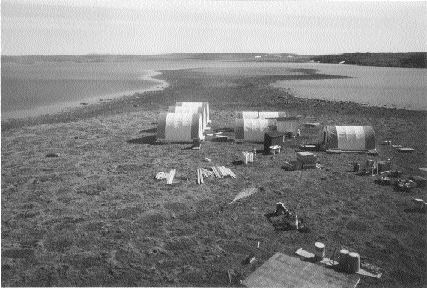There’s still nothing like a fashionable commodity to bring out the explorers, and nickel’s ascendancy is probably the best thing that has happened to Canadian exploration since, well, the last big nickel discovery.
And it is more than a little interesting that the “other” Labrador — the Cape Smith fold belt in the Nunavik (Ungava) region of northern Quebec — should have proved to be the most durable and prospective of the newer nickel camps. The most productive, too, though Voisey’s Bay was hit with a 5-year handicap in getting to production.
But the Cape Smith belt, with the
Added to that, discoveries of new deposits in the fold belt’s South Raglan trend by
Royalties’ work, which dates back to 1999, has allowed it to refine its own ideas on exploration in the area (T.N.M., Sept. 10/04). While Royalties went in with “fly it, grid it, drill it” thinking, the technical successes at Mesamax, Mequillon, and several other showings have taught its explorationists that subtle geophysical indicators and a good handle on the stratigraphy offer a better chance at good drill intersections.
Those lessons have been passed on, gratis, to Royalties’ little brother,
The Shoot Out prospects are in the Kenty Lake area southwest of Mesamax and Mequillon, about 75 km southwest of Mesamax, along the same South trend that hosts the Mesamax, Lac Mequillon, and Expo-Ungava deposits. Cominco (now
And drilling on previously known showings, with the advantage of better geophysical and structural information, has returned one success so far: six drill holes on the Alpha showing at West Shoot Out intersected massive and disseminated sulphides, with a 12.3-metre intersection in one hole grading 0.85% nickel and 0.43% copper, plus 0.42 gram platinum and 1.45 grams palladium per tonne (T.N.M., Oct. 1/04).
Getty zone
Another 20 km along strike to the southwest,
Canadian Royalties itself has had a further exploration success, drilling the northeastern extension of the Mequillon deposit. The inferred resource at Mequillon occupies part of a synform of sediments, basalt and mafic to ultramafic sills, with a gently plunging axis trending northeast. The resource calculation released in September limited it to a 300-metre-long conceptual open pit, but to the northeast, the mineralization has been intersected as far as 300 metres beyond that boundary; two closer drill holes demonstrated evidence that the mineralization is continuous.
The most distant hole, MQN04-30, intersected a 46.5-metre zone of nickel-copper sulphides, with average grades of 0.92% nickel, 1.11% copper, 0.04% cobalt, 0.3 gram gold, 0.96 gram platinum, and 3.34 grams palladium.
A hole collared 100 metres to the southwest of MQN04-30 intersected 19 metres with 0.51% nickel, 0.52% copper, 0.03% cobalt, 0.14 gram gold, 0.39 gram platinum and 1.44 grams palladium; another collared from the same location, but aimed for a shallower intersection with the zone, returned 2 metres of 0.34% nickel, 1.63% copper, 0.02% cobalt, 0.17 gram gold, 1.49 grams platinum and 4.25 grams palladium.
West and up-plunge from the known resource, five holes intersected shallow mineralization over widths of 1.4-15.2 metres. Average grades were higher than the resource grades, the best being in a 4.3-metre intersection that ran 1.48% nickel, 3.7% copper, 0.08% cobalt, 0.29 gram gold, 0.86 gram platinum and 3.39 grams palladium.
Bravo
Hole NW04-15 cut 15 metres of disseminated and massive sulphides in a zone more remarkable for its platinum and palladium content than for its base metals. Grades averaged 0.4 gram platinum and 2.3 grams palladium per tonne, plus 0.83% nickel, 0.74% copper.
NW04-21 intersected two zones of disseminated mineralization, one 8 metres long grading 0.18% nickel and 0.31% copper with 0.19 gram platinum and 0.81 gram palladium per tonne, and another, lower zone 15 metres long with 0.16% nickel, 0.24% copper, 0.19 gram platinum and 3 grams palladium.
Four other holes intersected disseminated mineralization with lower grades, rarely exceeding 0.1% nickel or copper, but with significant platinum and palladium content.
At the True North property, on the North trend, a 307-sq.-km claim block north of Falconbridge’s Cross Lake and C2 nickel deposits, the partners are earning a 70% interest from Vancouver-based


Be the first to comment on "Ungava a bright spot for nickel exploration"